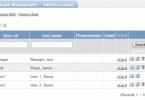Enterprise-level companies gather, store, process and manage vast amounts of data. These data sets are the very core of their workflow, management, operations, processes and business in general, which means having a proper data management strategy in place is a must,
Data management strategy can be explained as a roadmap for using all the different types of data that one company manages, making sure that each data piece is properly used and that it achieves its purpose. Data management plans make sure that each and every process and activity that takes place during data governance complement one another correctly, effectively and efficiently.

Managing enterprise data should be a process that is both effective and not too expensive, especially when it comes to preventing the following challenges:
- Dealing with corrupted, duplicate, or deleted data
- Dealing with badly documented sources or completely undocumented sources
- Duplicating efforts and costs regardless of siloed projects (that use the same data sets)
- Not following the rules and standards in terms of data archiving and regulatory compliance
- Dealing with time- and resource-consuming data governance processes that do not contribute to your business objectives in a parsimonious manner
- Sub-par security levels, etc
To mitigate these potentially hazardous challenges, we strongly suggest you create a solid enterprise data management strategy that is optimal for your unique company infrastructure and is optimized according to your teams and workflows.
Here are 4 basic steps to achieve just that.
1. Identify Data Types and Business Objectives
Enterprise companies produce vast amounts of data points, sometimes even billions on a daily basis. This is why it is crucial to properly identify the types of data you are handling and determine business objectives that will ultimately govern your data management strategy.
It is recommended that you determine the following:
- Your overall business end goals and objectives.
- Which data types should meet these goals.
- All the valuable insights and necessary information required to come up with the custom-tailored data management plan.
We suggest finding up to 5 use cases and/or case studies that are most similar to your data management infrastructure and operations. This will help you to start developing your own plan from there, especially in terms of strategy phases, tools, processes, governance, etc.
2. Establish How You Collect, Store, Analyze and Distribute Data
The next step should be establishing the ways your organization gathers, prepares, stores, archives, and distributes your data. During this stage, be sure to identify the owners and stakeholders for all the activities mentioned above, so here are some quick points to have in mind:
Data Collection
- Determine data sources
- Figure out if you are using both internal and external assets
- Think about if you need structured data, unstructured data, or both
- Establish the ways your data is collected
- Decide between manual and automated processes for each data management component
Data Preparation
- Think of the best ways to you organize and clean raw data so it is best fitted for analysis
- Identify incomplete and disparate data pieces
- Have consistent guidelines for nomenclature, the lineage for documentation, and metadata so all data pieces are easily discoverable
Data Storing
- Figure out the best ways to store your data
- Decide between using CSV, XML, relational databases
- Determine if you need a data lake
- Find the best ways to keep your data secured
Data Analysis and Distribution
- Establish good communication and collaboration among teams or departments
- Make end-user access to data and analysis easier
- Find the most effective ways to communicate valuable data insights
3. Use The Right Tools
Using the right technology and solutions is a prerequisite for building a proper data management strategy, so you must think carefully and perform thorough research on what tools and hardware you will be needing to perform the tasks involved.
Think about data infrastructure platforms, data management add-ons, analytics software, data and email archiving solutions, storage platforms and servers, and all-around data management tools. Also, always be sure to be on top of your game in terms of regulatory compliance standards when you use third-party solutions.
4. Properly Handle Data Governance Guidelines
High responsibility levels are involved in creating this type of strategy so be sure not to approach data governance tasks too lightly, especially when it comes to establishing and communicating policies and guidelines for correct usage of data.
To ensure that all data types are used in a correct and consistent manner across all teams within your organization, your data governance policies and procedures should be available to and understood by everyone inside your organization, not just the company owners and stakeholders.
Summary
Building a strong and consistent data management strategy is the very foundation of your projects, operations and business growth. However, not many enterprise owners are data experts at the same time, so outsourcing certain aspects of this process can help them automate these procedures and cut costs at scale.





Leave a Comment